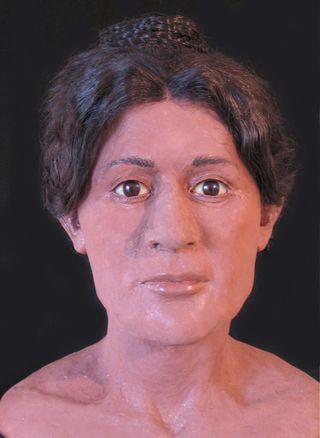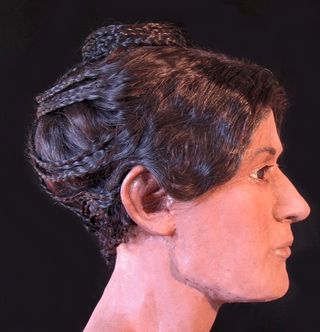Egyptian Mummy's Elaborate Hairstyle Revealed in 3D

Nearly 2,000 years ago, at a time when Egypt was under the control of the Roman Empire, a young woman with an elaborate hairstyle was laid to rest only yards away from a king's pyramid, researchers report.
She was 5 feet 2 inches in height, around age 20 when she died, and was buried in a decorated coffin whose face is gilded with gold. A nearby pyramid, at a site called Hawara, was built about 2 millennia before her lifetime. The location of her burial is known from archival notes.
High-resolution CT scans reveal that, before she was buried, her hair was dressed in an elaborate hairstyle.
"The mummy's hair is readily appreciable, with longer strands at the middle of the scalp drawn back into twists or plaits that were then wound into a tutulus, or chignon at the vertex (crown) of the head," writes a research team in a paper published recently in the journal RSNA RadioGraphics. They note that it was a popular hairstyle at the time, which may have been inspired by a Roman empress, Faustina I, who lived in the second century. [See Photos of Egyptian Mummy's Reconstruction]

Today, thanks to research and reconstruction work that includes high-resolution CT scans, anthropological analysis, 3D printing and facial reconstruction drawing, this woman, along with two other mummies, are being brought back to life. Their three-dimensional faces and hair, carefully reconstructed by professional forensic artist Victoria Lywood, of John Abbott College, are set to be revealed tomorrow (Jan. 25) at the Redpath Museum at McGill University in Montreal, Canada.
In pictures sent to LiveScience the reconstructions appear vividly real in every aspect, from the tone of their muscles to the color and style of their hair. It looks like they could be people living today.

"They are three human Egyptian mummies that have been trapped in the manner they held when laid to rest nearly 2,000 years ago. And now we can reveal what they might have looked like," the team writes in a press release. All three mummies were donated to the Redpath Museum in the 19th century.
Sign up for the Live Science daily newsletter now
Get the world’s most fascinating discoveries delivered straight to your inbox.
While two scientific papers have recently been published on them, and their reconstructed faces are set to be unveiled, there are still plenty of mysteries for Egyptologists to tackle. For instance, when researchers scanned the woman they found three puncture marks, each about an eighth of an inch (3-4 millimeters) across, on the right side of her abdominal wall, wounds that may have killed her, leading to the question — how did she get them?
"These wounds were believed to have occurred either before or shortly after death," the researchers write in their RadioGraphics paper, "although these CT findings are far from conclusive, it is possible that the punctures are related to the cause of death."
The 'matron'
Another mummy, dubbed the "white-haired matron," is of a woman who lived long enough to see her hair go gray, likely passing away sometime between the ages of 30 and 50. Radiocarbon dating indicates that she lived late in the time of Roman rule (A.D. 230-380), when Christianity was growing in Egypt and mummification was soon to go out of style. At 5 foot 3 inches, she was relatively tall for her time, and museum records indicate that she was found somewhere in the ancient Egyptian city of Thebes (modern-day Luxor).
She suffered from a problem quite common in ancient Egypt — bad, and rather painful, teeth. "Thecondition of the teeth of (the mummy) was poor," the team writes in the RadioGraphics paper, noting that she was missing several of them and that a large cavity, between two teeth, was visible along with several abscesses.
Theban male
The third reconstructed mummy lived a few centuries earlier than the other two, at a time when a dynasty of Greek kings ruled Egypt. If he and the matron could talk, they could sympathize with each other’s dental problems. [Mummy Melodrama: 9 Secrets of Otzi the Iceman]
The 5-foot-4-inch male mummy had numerous cavities, including one that caused a sinus infection, possibly killing him. His condition was so bad that in his final days he had a form of linen "packing," dipped in medicine, inserted into one of his cavities. According to records he also was found in Thebes, with CT scans showing that he died relatively young, likely in his 20s or early 30s.
Western University researcher Andrew Wade, a leading member of the team, said at a recent Egyptology symposium in Toronto that the development of high-resolution CT scans has played a key role in advancing the study of Egyptian mummies, including these three individuals, unveiling tiny details that help bring their past to life.
"The high spatial and contrast resolution of the last decade of CT studies of mummies has allowed us to examine the paleo-anatomic minutiae (of mummies)," he said.
Follow LiveScience on Twitter @livescience. We're also on Facebook & Google+.

Owen Jarus is a regular contributor to Live Science who writes about archaeology and humans' past. He has also written for The Independent (UK), The Canadian Press (CP) and The Associated Press (AP), among others. Owen has a bachelor of arts degree from the University of Toronto and a journalism degree from Ryerson University.
Most Popular


